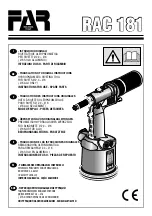
P2530-H
Safety Information
© Atlas Copco Industrial Technique AB - 9836 3984 00
5
• There should be a stand or a place available, on which
the machine can be safely placed.
• Work within a sealed-off area, if possible with protecting
walls.
• Explosive atmosphere must not be ignited - use acces-
sories of non-sparking material.
• Avoid chiseling into electric wiring hidden inside walls.
After the work is finished
• When finishing a job, disconnect the tool from its air
supply.
• Make sure that the tool is switched off and has come to a
complete stop before it is put down.
• Put down the tool carefully, so that there is no risk of the
tool starting by itself.
• Remove the chisel, die or punch when the work is over.
Maintenance
• Do not dismantle safety-related parts. These parts should
be completely replaced when damaged.
• Make sure you follow the service instructions and the
recommended service intervals.
Safety instructions
Additional safety information regarding portable air
tools:
• CAGI 2528 - B186.1, SAFETY CODE FOR POR-
TABLE AIR TOOLS, available from Global Engi-
neering Documents at https://global.ihs.com/ or call
+1 800 447-2273. In case of difficulty in obtaining
ANSI standards, contact ANSI via https://
www.ansi.org/
Air supply and connection hazards
• Air under pressure can cause severe injury.
• Always shut off air supply, drain hose of air pressure and
disconnect tool from air supply when not in use, before
changing accessories or when making repairs.
• Never direct air at yourself or anyone else.
• Whipping hoses can cause severe injury. Always check
for damaged or loose hoses and fittings.
• Do not use quick disconnect couplings at tool. Use hard-
ened steel (or material with comparable shock resis-
tance) threaded hose fittings. See instructions for correct
set up.
• Whenever universal twist couplings are used, lock pins
must be installed.
• Do not exceed maximum air pressure of 6.3 bar / 90
psig, or as stated on tool nameplate.
Projectile hazards
• Always shut off air supply, relieve hose of air pressure
and disconnect tool from air supply when changing ac-
cessories.
• Failure of the workpiece, accessory, retainer or even of
the tool itself could generate high velocity projectiles.
Even small projectiles can injure eyes and cause blind-
ness.
• Always wear impact-resistant eye and face protection
when involved with or near the operation, repair or
maintenance of the tool or changing accessories on the
tool.
• Be sure all others in the area are wearing impact-resis-
tant eye and face protection.
• Never operate a tool unless the accessory is retained in
the tool with a proper retainer (see parts list).
• To avoid injury, retainer parts must be replaced when
they become worn, cracked or distorted.
• On overhead work, wear a safety helmet.
• Ensure that the workpiece is securely fixed.
• Hold the accessory firmly against the work surface be-
fore starting the tool.
Operating hazards
• Use of the tool can expose the operator's hands to haz-
ards, including impacts, cuts and abrasions and heat.
Wear suitable gloves to protect the hands.
• Avoid direct contact with accessory and work surface
during and after work as they become heated and sharp.
• Operators and maintenance personnel must be physically
able to handle the bulk, weight and power of the tool.
• Hold the tool correctly: be ready to counteract normal or
sudden movements – have both hands available.
Accessory hazards
• Never use any chisel as a hand struck tool. They are
specifically designed and heat-treated to be used only in
air hammers.
• Select the correct shank and retainer for the tool being
used.
• Never use dull accessories as they require excessive
pressure and can break from fatigue.
• Never cool a hot accessory in water. Brittleness and
early failure can result.
• Use only recommended sizes and types of accessories
and consumables.
• Accessory breakage or tool damage may result from
prizing. Take smaller bites to avoid getting stuck.






































